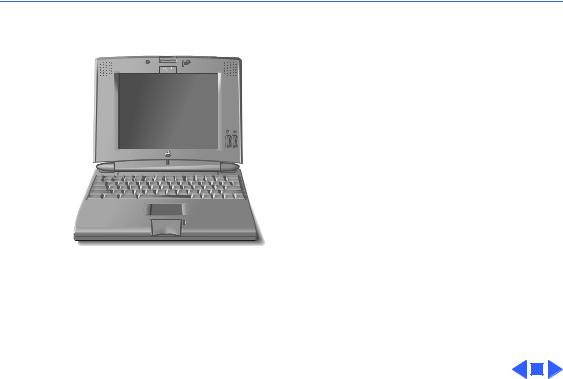Apple powerbook 500 Service Manual

K Service Source
PowerBook 500 Series
PowerBook 520, PowerBook 520c,
PowerBook 540, PowerBook 540c

K Service Source
Basics
PowerBook 500 Series

 Basics General Information - 1
Basics General Information - 1
|
General |
|
Information |
|
The PowerBook 500 Series |
|
introduces a number of |
|
technology and design |
|
innovations to the |
|
PowerBook family of |
|
computers. The series |
|
features a built-in |
|
trackpad, intelligent |
|
batteries, two battery bays, |
Figure: PowerBook 520, 520c, 540, and 540c |
an optional PCMCIA |
expansion module, and four |
|
|
|
|
displays: monochrome and |
|
color FSTN and active- |
|
matrix displays. |

Basics |
Repair Strategy - 2 |
|
|
|
|
Repair Strategy
Service the PowerBook 500 Series computers through module exchange and parts replacement. Customers can request on-site service from an Apple Authorized Service Provider Plus (AASP+) Apple Assurance (US only), or request a courier through the Apple Canada Technical Answerline (Canada only). They can also choose carry-in service from an AASP.
Ordering
Apple Service Providers planning to support the computer systems covered in this manual may purchase Service modules and parts to develop servicing capability. To order parts, use the AppleOrder (US only) or ARIS (Canada only) system and refer to “Service Price Pages.”

Basics |
Repair Strategy - 3 |
|
|
|
|
|
Large businesses, universities, and K-12 accounts must |
|
|
provide a purchase order on all transactions, including |
|
|
orders placed through the AppleOrder (US only) or ARIS |
|
|
(Canada only) system. |
|
USA Ordering
US Service Providers not enrolled in AppleOrder may fax their orders to Service Provider Support (512-908- 8125) or mail them to
Apple Computer, Inc. Service Provider Support MS 212-SPS
Austin, TX 78714-9125
For US inquiries, please call Service Provider Support at 800-919-2775 and select option #1.

Basics |
Repair Strategy - 4 |
|
|
|
|
Canadian Ordering
Canadian Service Providers not enrolled in ARIS may fax their orders to Service Provider Support in Canada (1-800-903-5284). For Canadian inquiries, please call Service Provider Support at 905-513-5782 and select option #3.

Basics |
Warranty/AppleCare/ARIS - 5 |
|
|
|
|
Warranty/AppleCare/ARIS
US Only
The PowerBook 500 Series computers are covered under the Apple One-Year Limited Warranty. The AppleCare Service Plan is also available for these products. Service Providers are reimbursed for warranty and AppleCare repairs made to these computers. For pricing information, refer to “Service Price Pages.”
Canada Only
The PowerBook 500 Series computers are covered under first-year AppleCare. The Extended AppleCare Service Plan is also available for these products. Service Providers are reimbursed for first-year warranty and Extended AppleCare repairs made to these computers. For pricing information, refer to “Service Price Pages.”

Basics |
Rear Panel - 6 |
|
|
|
|
Rear Panel
The illustration below shows the location of ports and connectors on the rear panel of the PowerBook 500 Series.

Basics |
PowerBook Screw Matrix - 7 |
|
|
|
|
PowerBook Screw Matrix
Nine different types of screws are used in the PowerBook 500 Series. All are Torx screws and require either a T-8 or T-6 Torx screwdriver.
Note: The legend for the screws follows on the next page.

Basics |
PowerBook Screw Matrix - 8 |
|
|
|
|
Legend for PowerBook 500 Series Screws
1Feet
2Hard drive, keyboard, bottom case (middle front), display assembly, floppy drive, daughterboard EMI shield (top edge), inside edge of top case, right side panel
3Display bezel, display, clutch, DAA
4Trackpad cable and actuator, daughterboard EMI shield (sides), motherboard standoff
5Rear panel
6Hard drive bracket
7Inverter board, interconnect board
8Bottom case (front corners), left side panel
9Floppy drive bracket

Basics |
PowerBook Cable Matrix - 9 |
|
|
|
|
PowerBook Cable Matrix
For a matrix of cables that work with specific models of the
PowerBook family of computers, refer to the PowerBook
Cable Matrix in the Hardware/Compatibility Charts tab.

Basics |
PCMCIA Module Handling - 10 |
|
|
|
|
PCMCIA Module Handling
The PCMCIA (Personal Computer Memory Card International Association) expansion module is an option for the PowerBook 500 Series. The module inserts into the computer’s second (left) battery bay and has two slots that accept a variety of third-party PCMCIA cards.
There are three types of PCMCIA cards: Type I (3 mm), Type II (5 mm), and Type III (10 mm). Type I and Type II cards fit in either the upper or lower slot of the expansion module. Type III cards fit in the lower slot and take up both slots.
The following are guidelines for properly handling the PCMCIA expansion module:
• Do not insert or remove the PCMCIA expansion module while the computer is on or in Sleep mode. if you do, the

Basics |
PCMCIA Module Handling - 11 |
|||
|
|
|
||
|
computer will shut down and all RAM contents will be |
|||
|
lost. |
|||
|
• Eject the PCMCIA module using the lever at the front of |
|||
|
the module; eject a PCMCIA card using the PCMCIA Eject |
|||
|
control panel or the PCMCIA Quick Eject module in the |
|||
|
computer’s Control Strip. |
|||
|
• Keep the protective cap that comes with the module and |
|||
|
place it back on the module when it is not in use. |
|||
|
• Do not open the module or insert anything other than a |
|||
|
PCMCIA card into the card slots. |
|||
|
• Keep the module in a safe place, away from small objects |
|||
|
that might fall into it. |
|||
|
• Before ejecting a PCMCIA card, make sure nothing is |
|||
|
blocking the card’s slot. To immediately reinsert the |
|||
|
card, pull it out an inch more and then push it back in. |
|||
|
• Use only cards that are compatible with the PCMCIA |
|||
|
expansion module. Refer to the compatibility |
|||
|
information that came with the card. |
|||
|
|
|
|
|
|
|
|
|
|

Basics |
Battery Information - 12 |
|
|
|
|
Battery Information
The PowerBook 500 Series computers include one or two nickel-metal-hydride (NiMH) batteries. Each battery provides power for up to 3.5 hours of work time, depending on the battery conservation features employed. A smart processor included in each battery pack indicates the battery’s charge status.
For instructions on how to verify the battery voltage, see the Additional Procedures chapter of this manual.
For additional information on PowerBook batteries, voltages, ampere hours, and part numbers, see the PowerBook Battery Matrix in Hardware/Compatibility Charts.

Basics |
Battery Information - 13 |
|
|
|
|
Battery Handling
±Warning: NiMH batteries contain toxic materials. Send undamaged, dead batteries to Apple for recycling—do not discard dead batteries with other waste. If the battery is damaged, do not return it to Apple. Dispose of damaged batteries according to local ordinances. Review batteryhandling and disposal instructions in the Safety document (path: Bulletins/Safety).
The following are guidelines for properly handling the
PowerBook 500 Series battery:
• Handle the battery carefully. Do not drop, puncture, disassemble, mutilate, or incinerate it.
• Do not short-circuit the battery terminals.
• Do not leave a battery in the computer for longer than a week without plugging in the power adapter.
• Do not leave the battery in hot locations (such as the

Basics |
Battery Information - 14 |
|
|
|
|
|
trunk of a car). |
|
• |
Keep the battery in a cool, dark place; do not store it for |
|
|
longer than 6 months without recharging. |
|
• If you are using one battery: completely discharge and |
||
|
then recharge the battery once every 90 days. |
|
• |
If you are using two batteries: swap the left and right |
|
batteries every month.
• Fully charge a replacement battery before using it; Apple ships batteries in a partially charged state.

K Service Source
Specifications
PowerBook 500 Series

Specifications |
Introduction - 1 |
|
|
|
|
Introduction
You can also find specifications information for this product in the
Spec Database, which you can access in one of three ways:
— Launch it directly by double-clicking the Apple Spec Database runtime alias at the top level of the Main Service Source CD.
— Select "Apple Spec Database" from the Service Source dropdown main menu.
— Click the Acrobat toolbar icon for the database, which is near the right end of the toolbar with the letters "SP."

Specifications |
Processor - 2 |
|
|
|
|
PB 520/520c
PB 540/540c
Addressing
Processor
Motorola 68LC040 microprocessor 50/25 MHz
Motorola 68LC040 microprocessor 66/33 MHz
32-bit internal registers
32-bit address bus
32-bit data bus

Specifications |
Memory - 3 |
|
|
|
|
RAM
ROM
PRAM
VRAM
Clock/Calendar
Memory
4 MB RAM installed on the daughterboard
Expandable to 12 MB with 8 MB Apple RAM expansion card Expandable to 36 MB with third-party RAM expansion card
2 MB
256 bytes of parameter memory
512K of static video display memory
CMOS custom chip with long-life lithium battery

Specifications |
Disk Storage - 4 |
|
|
|
|
Disk Storage
Floppy Drive
Hard Drive
15 mm high, internal, 1.4 MB Apple SuperDrive
2.5 in. hard drives (160 MB, 240 MB, and 320 MB capacities)

Specifications |
I/O Interfaces - 5 |
|
|
|
|
SCSI
Apple Desktop Bus
Serial
Sound
I/O Interfaces
HDI-30 SCSI port with 1.5 MB/sec. transfer rate Supports up to six external SCSI devices
Connect SCSI device to computer with HDI-30 SCSI system cable.
Apple Desktop Bus (ADB) port
200 mA maximum current draw for all ADB devices RS-422 serial port; mini DIN-8 connector
Stereo sound-in port
Stereo sound-out headphone jack; standard 3.5 mm stereo miniplugs

|
Specifications |
I/O Interfaces - 6 |
|||
|
|
|
|
||
Video |
Micro DV-14 video-out port; 8 bit, 256 color video output |
||||
|
|
Supports most Macintosh, VGA, and SVGA monitors |
|||
Ethernet |
High-speed Ethernet port; Apple AUI connector |
||||
Processor-Direct Slot |
90-pin processor-direct slot (PDS) for PDS devices or optional |
||||
|
|
Personal Computer Memory Card International Association |
|||
|
|
(PCMCIA) adapter/PCMCIA expansion module (allows use of |
|||
|
|
two Type II or one Type III PCMCIA-type card) |
|||
Power Adapter |
Power adapter port |
||||
Modem |
Slot for optional internal modem |
||||
Security |
Slot for third-party security equipment |
||||
|
|
|
|
|
|
|
|
|
|
|
|

|
Specifications |
I/O Devices - 7 |
|
|
|
|
|
|
|
I/O Devices |
|
Keyboard |
Built-in keyboard with 12 function keys |
||
|
|
76 keys domestic, 77 keys ISO |
|
|
|
Two-level tilt adjustment |
|
Trackpad
Microphone
Solid-state trackpad
Electret, omnidirectional
Output voltage of 4 mV, peak to peak

Specifications |
Sound and Video - 8 |
|
|
|
|
Sound Generator
PB 520 Video
Display
PB 520c Video
Display
PB 540 Video
Display
Sound and Video
Apple sound chip provides 16-bit sound capable of driving stereo headphones or other stereo equipment through the sound jack
Built-in stereo speakers
9.5-in. (24 cm) diagonal screen
Backlit, FSTN grayscale display (16 levels); 640 x 480 pixels
9.5-in. (24 cm) diagonal screen
Backlit, dual-scan color display (256 levels); 640 x 480 pixels
9.5-in. (24 cm) diagonal screen
Backlit, active-matrix grayscale display (16 levels); 640 x 480

|
Specifications |
Sound and Video - 9 |
|||
|
|
|
|
||
PB 540c Video |
9.5-in. (24 cm) diagonal screen |
||||
Display |
Backlit, active-matrix color display; 640 x 400 pixels at |
||||
|
|
thousands of colors; 640 x 480 pixels at 256 colors |
|||
|
|
|
|
|
|
|
|
|
|
|
|

Specifications |
Electrical - 10 |
|
|
|
|
Electrical
Main Battery
One or two nickel-metal-hydride (NiMH) batteries Up to 3.5 hours of usage per battery before recharging
Recharge time: 2 hours in shut down or sleep mode, 4 hours while computer is running
Power Adapter
110–240 VAC line voltage 40 W, 50–60 Hz

|
Specifications |
Physical - 11 |
|||
|
|
|
|
||
|
|
Physical |
|||
Dimensions |
|
|
|
|
|
Height |
2.25 in. (5.7 cm) |
||||
Width |
11.5 in. (29.2 cm) |
||||
Depth |
9.65 in. (24.5 cm) |
||||
Weight |
|
|
|
|
|
PB 520/520c |
6.4 lb. (2.9 kg) with one battery |
||||
PB 540/540c |
7.3 lb. (3.3 kg) with two batteries |
||||
|
|
|
|
|
|
|
|
|
|
|
|

Specifications |
Environmental - 12 |
|
|
|
|
Environmental
Operating
Temperature
Storage
Temperature
Relative Humidity
Operating Altitude
Storage Altitude
50–104°F (10–40°C)
-13 to 140°F (-25 to 60°C)
20–80% noncondensing 0–10,000 ft. (0–3048 m) 0–15,000 ft. (0–4572 m)

Specifications |
Other - 13 |
|
|
|
|
Internal Modem
SCSI Adapter
PCMCIA Module
Other
Sends and receives data at 19.2 bps; sends and receives faxes at 14.4 bps
Enables connection between PowerBook computer and desktop Macintosh (PowerBook appears as a hard drive on the desktop)
Enables use of two Type I or II PCMCIA cards or one Type III card
